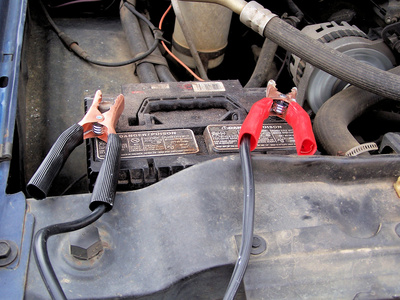
Troubleshooting a 2002 Ford Focus that won't start differs depending on whether the engine will crank but won't start or will not crank at all. If the engine does not crank, or turn over, start your troubleshooting with the electrical system. If the engine will crank but won't start, look into the fuel delivery system and the air system. Complete basic troubleshooting with standard tools and equipment. More involved troubleshooting may require a trained service technician and the use of an electronic service tool to diagnose complicated start problems.
Verify that the battery terminal connections are tight and free of corrosion, oil, dirt and debris. Clean with a wire brush as required. Verify that the chassis ground connection is tight and free of corrosion, oil, dirt and debris. Clean as required. Set the digital voltmeter to read resistance and measure the resistance between the negative battery terminal and the chassis ground. The resistance should be less than 1 ohm. If the resistance is greater than 1 ohm, there is a problem with the chassis ground cable or connection. Repair or replace as required.

Measure the voltage across the battery terminals. The voltage should be approximately 12 volts. If the voltage is less than 12 volts, place the battery on a charger.
Turn the key switch to "On" and measure the voltage across the starter terminals. The voltage should be approximately 12.8 volts. If the voltage is 12.8 volts, the starter is getting the proper voltage but will not engage the flywheel. Remove the starter and repair or replace it as required. If the voltage is less than 12 volts, there is a problem with the starter relay.
Follow the wires from the starter solenoid to the starter relay. Verify that they are clean and free of corrosion, abrasion or damage. Repair or replace as required. Turn the key switch to "Start" and measure the voltage across the starter relay, terminals 85 and 86. The voltage should be approximately 12.8 volts. If the voltage is 12.8 volts, there is a problem with the starter relay. Replace the relay. If the voltage is less than 12 volts, there is a problem with the key switch start circuit. Repair as required.
Locate the air filter on the air intake system. Remove the cover and inspect the air filter. The filter should be clean and free of dirt and debris. A clogged air inlet will limit the amount of air into the chamber, causing hard starts and engine stalls.
Locate the fuel filter under the chassis frame. Follow the fuel line from the fuel tank to the filter. Turn the key switch "Off" and remove the fuel pump relay from the fuse/relay box. Refer to your owner's manual for more details. Turn the key to "Start." Wait a moment and turn the key off. Do this several times to relieve the pressure in the fuel system. Remove the fuel lines from the filter. Inspect the filter. Replace the filter if it is dirty or clogged. A clogged fuel filter will limit the amount of fuel into the cylinder, causing hard starts and engine stalls.
Replace the fuel pump relay. Turn the key switch "On" and listen for the fuel pump to turn on -- it's a quiet hum or buzz that lasts for just a couple seconds. If you hear nothing, turn the key switch and remove the fuel pump relay. Turn the key switch to "Start" and measure the voltage across terminals 85 and 86. The voltage should be approximately 12.8 volts. If the voltage is 12.8 volts, inspect the wiring from the fuel pump relay to the fuel pump. The wiring should be free of corrosion, abrasion and damage. Replace as required. If the wiring is okay, replace the fuel pump relay. If the voltage is less than 12 volts there is a problem in the wiring to the fuel pump relay. Repair as required.
Take the car to a qualified technician if the engine still will not start. The technician will use an electronic service tool to monitor the engine sensors, engine timing and electronic control module fault codes. The data collected from the electronic service tool will aid the technician in diagnosing why the engine will not start.